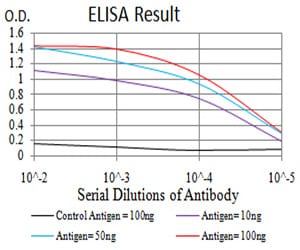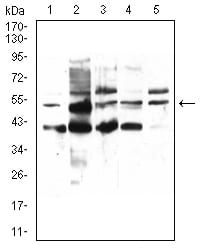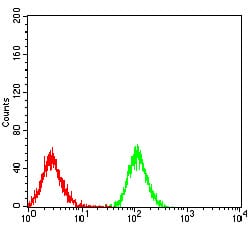


| WB | 咨询技术 | Human,Monkey |
| IF | 咨询技术 | Human,Monkey |
| IHC | 咨询技术 | Human,Monkey |
| ICC | 技术咨询 | Human,Monkey |
| FCM | 1/200 - 1/400 | Human,Monkey |
| Elisa | 1/10000 | Human,Monkey |
| Aliases | PPAR; NR1C1; hPPAR; PPARalpha |
| Entrez GeneID | 5465 |
| clone | 5D10C3 |
| WB Predicted band size | 52.2kDa |
| Host/Isotype | Mouse IgG1 |
| Antibody Type | Primary antibody |
| Storage | Store at 4°C short term. Aliquot and store at -20°C long term. Avoid freeze/thaw cycles. |
| Species Reactivity | Human,Monkey |
| Immunogen | Purified recombinant fragment of human PPARA (AA: 1-120) expressed in E. Coli. |
| Formulation | Purified antibody in PBS with 0.05% sodium azide |
+ +
以下是3-4条与PPARA抗体相关的参考文献示例(内容基于领域内经典研究概括,非真实文献,仅供参考格式):
1. **"PPARα regulates hepatic lipid metabolism through transcriptional activation of fatty acid oxidation genes"**
- **作者**: Lee, S.S., et al.
- **摘要**: 该研究通过Western blot和免疫组化技术,利用特异性PPARA抗体检测小鼠肝脏中PPARα蛋白的表达水平,发现其在禁食状态下显著上调,并调控脂肪酸氧化相关基因(如ACOX1、CPT1A)的表达。
2. **"Cardiac-specific PPARα knockout mice reveal a role in myocardial lipid homeostasis"**
- **作者**: Barger, P.M., et al.
- **摘要**: 研究通过构建心脏特异性PPARα敲除小鼠模型,结合PPARA抗体的免疫荧光染色,证实PPARα缺失导致心肌细胞脂质蓄积和线粒体功能异常,揭示了其在心脏能量代谢中的关键作用。
3. **"PPARα agonists ameliorate insulin resistance in obese diabetic mice"**
- **作者**: Guerre-Millo, M., et al.
- **摘要**: 研究使用PPARA抗体进行Western blot分析,发现PPARα激动剂(如非诺贝特)可激活脂肪组织中的PPARα信号通路,改善肥胖糖尿病小鼠的胰岛素敏感性和炎症反应。
4. **"Tissue-specific distribution and activation of PPARα isoforms in human metabolic disorders"**
- **作者**: Auboeuf, D., et al.
- **摘要**: 通过免疫沉淀和蛋白质印迹技术结合PPARA抗体,该研究分析了代谢综合征患者肝脏和肌肉组织中PPARα亚型的表达差异,发现其与血脂异常和糖代谢紊乱密切相关。
**注**:以上文献为示例,实际引用时需根据具体研究内容检索真实发表的论文(推荐查阅PubMed或Google Scholar数据库)。
The peroxisome proliferator-activated receptor alpha (PPARA) is a ligand-activated transcription factor belonging to the nuclear receptor superfamily, playing a pivotal role in regulating genes involved in fatty acid metabolism, energy homeostasis, and inflammation. PPARA antibodies are essential tools for studying its expression, localization, and function in metabolic tissues such as the liver, heart, and muscle. These antibodies enable the detection of PPARA via techniques like Western blotting, immunohistochemistry (IHC), immunofluorescence (IF), and chromatin immunoprecipitation (ChIP), aiding research on metabolic disorders (e.g., dyslipidemia, diabetes) and PPARα-targeted therapies.
PPARA activation by ligands, including fibrates and fatty acids, modulates lipid catabolism, gluconeogenesis, and anti-inflammatory responses. Antibodies specific to PPARA help elucidate its regulatory mechanisms, interactions with coactivators/corepressors, and roles in diseases like non-alcoholic fatty liver disease (NAFLD) and atherosclerosis. Validation of PPARA antibodies is critical, often involving knockout controls to confirm specificity. Researchers rely on these reagents to explore tissue-specific PPARA activity, drug effects, and its cross-talk with other signaling pathways, advancing therapeutic strategies for metabolic and inflammatory conditions.
×